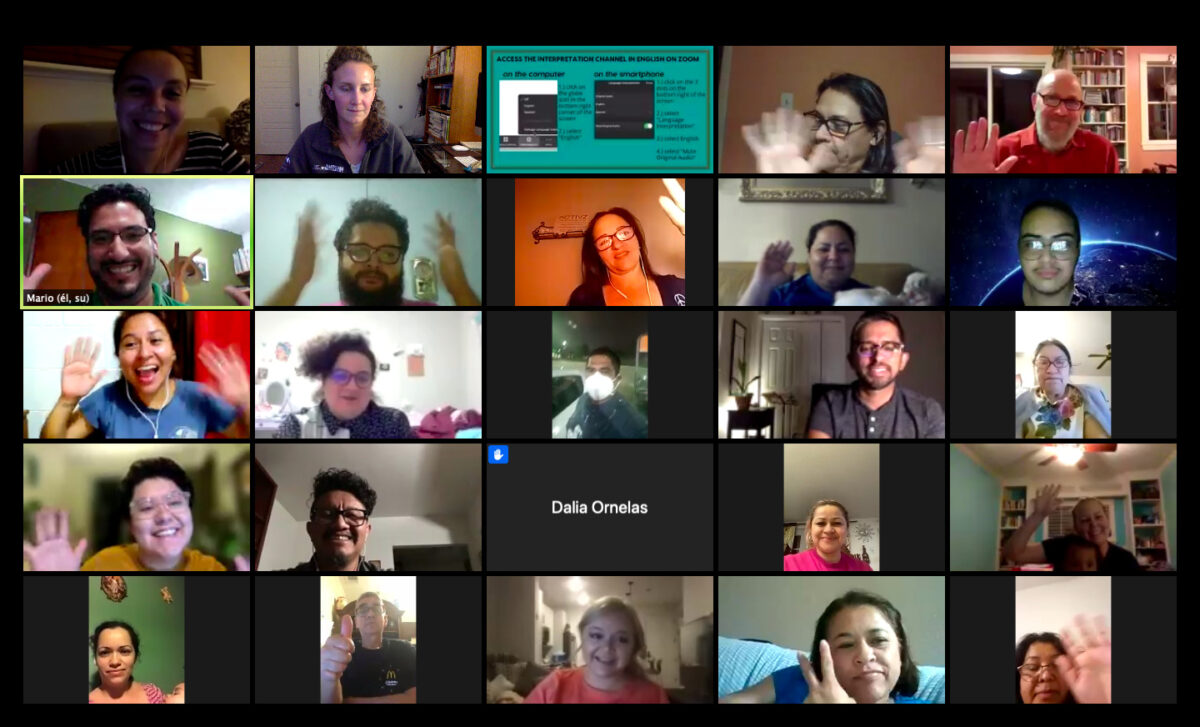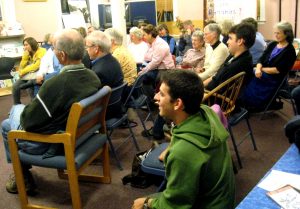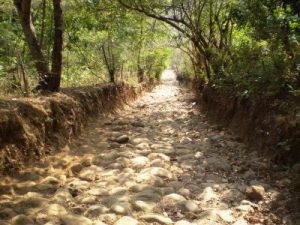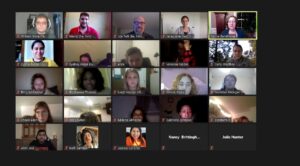Education, Sister Cities
Exploring the Braid of Oppression with Workers Defense Project
(EN ESPAÑOL ABAJO)
Last week, the Popular Education team lead a workshop with Workers Defense Project. The workshop’s theme explored what we called the “Braid of Oppression.” The Braid of Oppression is a concept Central American organizers use to understand how colonialism, capitalism, and patriarchy are individual forces–or strands–that criss-cross and interact with each other and create a braid that is stronger than any of the strands alone. In the US we’re more likely to use the word “inequality” instead of capitalism, and “sexism” instead of patriarchy, but these social forces are all part of the braid.
We began the evening by defining terms together so we would have a shared vocabulary for the discussion. In the photo below, Zulma is guiding a discussion on what defines oppression. Mario is typing participants’ ideas into a JamBoard.
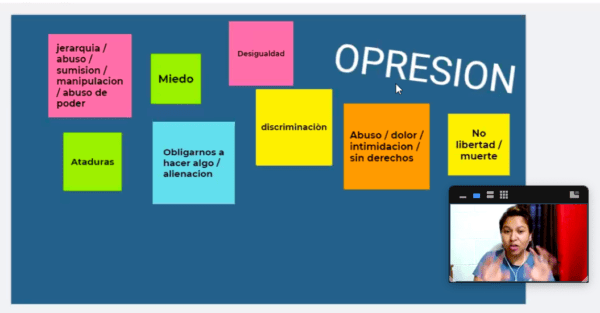
Next, we divided into groups and looked at photos that represented themes from the Braid of Oppression. Participants had to decide which strand of the braid was reflected in the photos. Below, Workers Defense Project staff Candelario asks his group how an aerial photo of Mexico City might represent the strands of both capitalism and colonialism.
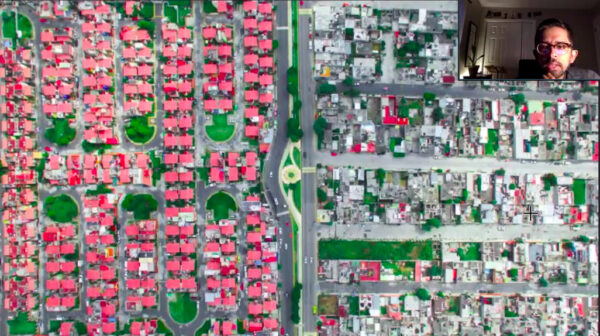
We then united as a large group and shared ideas from our small group discussion. Below is a photo of Mario asking for groups’ reflections on a different photo.
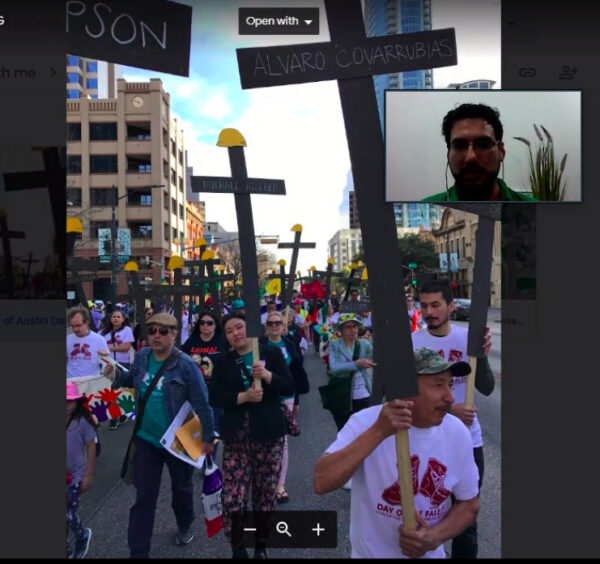
After considering how the Braid of Oppression operates in our world, we shifted gears to think about people power. We called this The Braid of People Power, of course. As long as there has been oppression there has been resistance to oppression, going back to the earliest stories we tell about ourselves. To effectively resist we need to build our power. This means creating our own Braid of People Power, bringing together power from multiple sources to create a strong movement.
With help from sources from CRIPDES and Equipo Maiz, we presented a short history of El Salvador’s anti-mining campaign. Below is a photo of Zulma summarizing this social movement. Through discussion, the group noted the importance of organizing, resistance, action at the base in the communities, and that uniting multiple strands of power is much stronger than using just one.
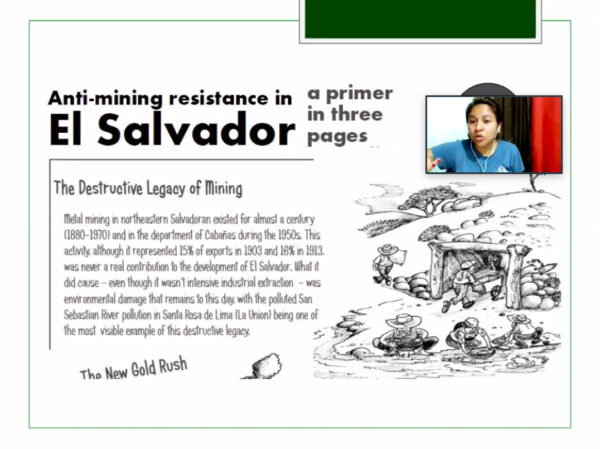
To wrap things up, we divided into small groups one last time. In this activity, each group had a topic (either patriarchy, colonialism, racism or capitalism). Participants in each group created two news reports based on their work in Workers Defense Project. Participants analyzed strategies that helped dissolve the Braid of Oppression and/or built People Power. The groups joined together and read their reports as newscasters. Each group shared thoughts on what the organization was doing to address that issue and what else could also be done.
USESSC is really happy to contribute to the internal analysis of this ally organization. If you think this could be helpful for your organization or class, don’t hesitate in contacting us. This is also another way to support the finances of our network during this pandemic times.
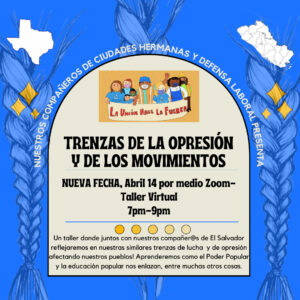
La semana pasada, el equipo de Educación Popular organizó un taller en español con la Organización Proyecto de Defensa Laboral. En él exploramos lo que llamamos la “Trenza de la opresión”. La trenza de la opresión es un concepto que utilizan los organizadores centroamericanos para comprender cómo el colonialismo, el capitalismo y el patriarcado son fuerzas individuales, o hebras, que se entrecruzan e interactúan entre sí y crean una trenza que es más fuerte que cualquiera de las hebras por separado. En Estados Unidos es más probable que usemos la palabra “desigualdad” en lugar de capitalismo, y “sexismo” en lugar de patriarcado, pero todas estas fuerzas sociales son parte de dicha trenza.
Comenzamos la velada definiendo los términos juntos para tener un vocabulario compartido durante la discusión.
A continuación, nos dividimos en grupos y miramos fotos que representaban temas de la Trenza de la opresión. Los participantes tuvieron que decidir qué hebra de la trenza se reflejaba en las fotos. Luego, en plenaria, compartimos sobre nuestra discusión.
Después de considerar cómo opera la Trenza de la Opresión en nuestro mundo, reflexionamos sobre el poder de las personas. A esto lo llamamos La trenza del poder popular, por supuesto. Donde ha habido opresión, ha habido resistencia. Para resistir de manera efectiva, necesitamos desarrollar nuestro poder. Esto significa crear nuestra propia Trenza de Poder Popular, uniendo el poder de múltiples fuentes para crear un movimiento fuerte.
Con la ayuda de materiales de CRIPDES y Equipo Maiz, presentamos una breve historia de la campaña contra la minería metálica en El Salvador. Durante la discusión, el grupo señaló la importancia de la organización, la resistencia, la acción en la base de las comunidades, y que unir múltiples ramas de poder tiene mucha más fuerza que usar solo una.
Para terminar, nos dividimos en grupos pequeños por última vez. En esta actividad, cada grupo tenía un tema (ya sea patriarcado, colonialismo, racismo o capitalismo). Los participantes de cada grupo crearon dos informes de noticias basados en su trabajo con Proyecto de Defensa Laboral. Los participantes analizaron estrategias que ayudaron a disolver la trenza de la opresión y / o desarrollaron el poder popular. En el pleno, los grupos leyeron sus reportajes como presentadores de noticias. Cada grupo compartió sus pensamientos sobre lo que la organización estaba dejando de lado para abordar ese problema y qué pasos sí se han tomado respecto a dicho problema.
USESSC está muy feliz por haber realizado el primero de los dos talleres programados con esta organización amiga. Si a usted le interesa desarrollar un taller en línea con su organización o clase, no dude en contactarnos. Esto es también de utilidad para que Ciudades Hermanas recaude fondos en estos tiempos de pandemia.

